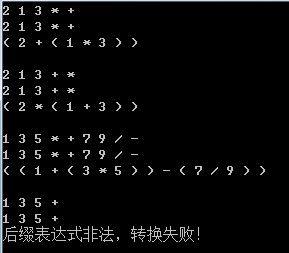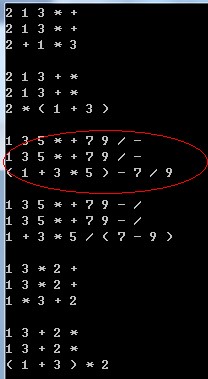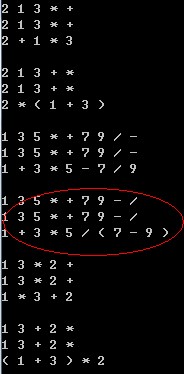后缀表达式转换为中缀表达式
后缀表达式转换为中缀表达式
之前我们介绍过《中缀表达式转化为后缀表达式》,现在我们想得到其逆过程,即如何由后缀表达式转换为中缀表达式。
目前我先给出我的一种理解和实现,其他方法以后再议。
有关中缀表达式的词法分析,本文不作考虑,而是直接用加了空格硬分割操作符和操作数的后缀表达式。
我们先来回忆一下后缀表达式的计算方法,可参考《后缀表达式的计算》。后缀表达式的计算过程为:首先设置一个操作数栈,对后缀表达式进行从左到右的扫描,如果是操作数,则直接压栈,如果是操作符,则从操作数栈中弹出相应的操作数结合当前操作符进行相应的运算,后将运算而得的结果压入到栈中,直至扫描完整个栈后,如果该中缀表达式是合法的,则操作数栈中应该有且只有一个元素,该元素即为后缀表达式的结果。
我们的方法是借鉴于后缀表达式计算的算法,基本算法逻辑都是一样的,不同的是,当我们扫描到操作符时,我们不做数值的运算,而是将相应的操作数和操作符进行拼接,并将拼接后的表达式压栈,直至扫描完成整个后缀表达式后,如果该后缀表达式是合法的,那么最后栈中应该只有一个元素,该元素即为后缀表达式对应的中缀表达式。这里的栈我们不能称之为操作数栈了,我们称其为表达式栈。
另外,在我们的后缀表达式中,我们也是只局限于加减乘除四种运算。
具体的程序如下:
// 后缀表达式转换为中缀表达式 #include <iostream> #include <sstream> #include <string> #include <vector> #include <stack> #include <set> using namespace std; void get_postfix(vector<string>& postfix) { postfix.clear(); string line, op_op; getline(cin, line); istringstream sin(line); while (sin >> op_op) { postfix.push_back(op_op); } } void init_operators(set<string>& optors) { optors.clear(); optors.insert("+"); optors.insert("-"); optors.insert("*"); optors.insert("/"); } bool is_operator(const set<string>& optors, const string& str) { auto cit = optors.find(str); if (cit != optors.end()) { return true; } else { return false; } } void post_to_in(const vector<string>& postfix, string& infix, const set<string>& optors) { infix.clear(); if (postfix.empty()) { return; } // 表达式栈 stack<string> exp_stk; string a, b, c; for (auto i = 0; i != postfix.size(); ++i) { if (!is_operator(optors, postfix[i])) { exp_stk.push(postfix[i]); } else { switch (postfix[i][0]) { case '+': case '-': case '*': case '/': b = exp_stk.top(); exp_stk.pop(); a = exp_stk.top(); exp_stk.pop(); c = "( " + a + " " + postfix[i] + " " + b + " )"; exp_stk.push(c); break; default: break; } } } if (exp_stk.size() == 1) { infix = exp_stk.top(); } else { infix = "后缀表达式非法,转换失败!"; } } void display(const vector<string>& strs) { for (auto cit = strs.begin(); cit != strs.end(); ++cit) { cout << *cit << ' '; } cout << endl; } int main() { vector<string> postfix; string infix; set<string> optors; init_operators(optors); while (1) { get_postfix(postfix); post_to_in(postfix, infix, optors); display(postfix); cout << infix << endl; cout << endl; } return 0; }

从程序的运行结果我们可以看到,可以得到想要的结果。但是,每个单元子表达式都会加上了括号,有些括号并不是需要的。
我们在后缀转中缀的过程中,并没有涉及加减乘除的优先级关系,针对每种运算符我们都是“加括号”处理。这种势必会造成产生多余的括号。
下面我们尝试去除多余的括号。
首先,我们举个例子:对于后缀表达式:
2 1 3 * +
我们程序得到的结果为:
( 2 + ( 1 * 3 ) )
而去除多余的括号后,其结果应该为:
2 + 1 * 3
对于后缀表达式:
2 1 3 + *
我们程序得到的结果为:
( 2 * ( 1 + 3 ) )
而最简的形式应该为:
2 * ( 1 + 3 )
同样,对于后缀表达式:
|
后缀表达式 |
程序得到的结果 |
最简形式 |
|
1 3 * 2 + |
( ( 1 * 3 ) + 2 ) |
1 * 3 + 2 |
|
1 3 + 2 * |
( ( 1 + 3 ) * 2 ) |
( 1 + 3 ) * 2 |
我们的程序处理的方式是,当遇到操作符时,默认都会加上括号,显然有些括号是不需要加的,关于括号有没有必要加,需要取决于后面的操作符。如果后面的操作符优先级大于当前操作符,则需要加上括号,如果小于或等于则不需要加括号。如果当前操作符是最后一个操作符,则也不需要添加括号。这就需要我们建立两个数据结构:
1.记录操作符优先级的结构
2.按照后缀表达式中操作符的顺序,记录后缀表达式中的所有操作符
根据以上分析,我们改进后的程序为:
// 改进1 #include <iostream> #include <sstream> #include <string> #include <vector> #include <stack> #include <map> using namespace std; void get_postfix(vector<string>& postfix) { postfix.clear(); string line, op_op; getline(cin, line); istringstream sin(line); while (sin >> op_op) { postfix.push_back(op_op); } } void init_operators(map<string, int>& optors) { optors.clear(); optors["+"] = 100; optors["-"] = 100; optors["*"] = 200; optors["/"] = 200; } bool is_operator(const map<string, int>& optors, const string& str) { auto cit = optors.find(str); if (cit != optors.end()) { return true; } else { return false; } } void post_to_in(const vector<string>& postfix, string& infix, map<string, int>& optors) { infix.clear(); if (postfix.empty()) { return; } vector<string> post_optors; // 按照后缀表达式操作符的顺序,记录表达式中的操作符 for (auto i = 0; i != postfix.size(); ++i) { if (is_operator(optors, postfix[i])) { post_optors.push_back(postfix[i]); } } auto pos = 0; // 记录当前操作符在post_optors中的位置 // 表达式栈 stack<string> exp_stk; string a, b, c; for (auto i = 0; i != postfix.size(); ++i) { if (!is_operator(optors, postfix[i])) { exp_stk.push(postfix[i]); } else { switch (postfix[i][0]) { case '+': case '-': case '*': case '/': b = exp_stk.top(); exp_stk.pop(); a = exp_stk.top(); exp_stk.pop(); // 加括号 || 不加括号 ++pos; if (pos < post_optors.size() && optors[post_optors[pos]] > optors[postfix[i]]) { c = "( " + a + " " + postfix[i] + " " + b + " )"; } else { c = a + " " + postfix[i] + " " + b; } exp_stk.push(c); break; default: break; } } } if (exp_stk.size() == 1) { infix = exp_stk.top(); } else { infix = "后缀表达式非法,转换失败!"; } } void display(const vector<string>& strs) { for (auto cit = strs.begin(); cit != strs.end(); ++cit) { cout << *cit << ' '; } cout << endl; } int main() { vector<string> postfix; string infix; map<string, int> optors; init_operators(optors); while (1) { get_postfix(postfix); post_to_in(postfix, infix, optors); display(postfix); cout << infix << endl; cout << endl; } return 0; }

从程序结果我们可以看出,程序基本符合预期,但是对于:
|
后缀表达式 |
程序得到的结果 |
最简形式 |
|
1 3 5 * + 7 9 / - |
( 1 + 3 * 5 ) – 7 / 9 |
1 + 3 * 5 – 7 / 9 |
原因在于,我们检测到+的优先级小于/的优先级,所以对 1 + 3 * 5 加了括号,但是 / 前面已经有了两个操作数:7和9,所以,对于 1 + 3 * 5 已没有必要添加括号,这就需要我们还要考虑相邻两个操作符在后缀表达式中的位置关系,不仅仅是前后的关系,还有他们之间的操作数的个数与他们是几目运算符的关系。
这里,我们对数据结构:记录操作符在后缀表达式中的顺序,还要记录操作符对应于后缀表达式中的位置。
具体的程序如下:
// 改进2 #include <iostream> #include <sstream> #include <string> #include <vector> #include <stack> #include <map> using namespace std; void get_postfix(vector<string>& postfix) { postfix.clear(); string line, op_op; getline(cin, line); istringstream sin(line); while (sin >> op_op) { postfix.push_back(op_op); } } void init_operators(map<string, int>& optors) { optors.clear(); optors["+"] = 100; optors["-"] = 100; optors["*"] = 200; optors["/"] = 200; } bool is_operator(const map<string, int>& optors, const string& str) { auto cit = optors.find(str); if (cit != optors.end()) { return true; } else { return false; } } void post_to_in(const vector<string>& postfix, string& infix, map<string, int>& optors) { infix.clear(); if (postfix.empty()) { return; } // 添加位置信息 struct op_pos { string op; // 操作符 int pos; // 在后缀表达式中的位置 int pol; // 几目运算符 }; vector<op_pos> post_optors; // 按照后缀表达式操作符的顺序,记录表达式中的操作符 op_pos tmp; for (auto i = 0; i != postfix.size(); ++i) { if (is_operator(optors, postfix[i])) { tmp.op = postfix[i]; tmp.pos = i; tmp.pol = 2; // 可以在optors中添加几目信息,并在这里通过optors进行赋值 post_optors.push_back(tmp); } } auto pos = 0; // 记录当前操作符在post_optors中的位置 // 表达式栈 stack<string> exp_stk; string a, b, c; for (auto i = 0; i != postfix.size(); ++i) { if (!is_operator(optors, postfix[i])) { exp_stk.push(postfix[i]); } else { switch (postfix[i][0]) { case '+': case '-': case '*': case '/': b = exp_stk.top(); exp_stk.pop(); a = exp_stk.top(); exp_stk.pop(); // 加括号 || 不加括号 ++pos; if (pos < post_optors.size() && optors[post_optors[pos].op] > optors[postfix[i]] && post_optors[pos].pos - post_optors[pos - 1].pos < post_optors[pos].pol + 1 /* 这里需要加1,因为记录的是两个操作符的位置 */) { c = "( " + a + " " + postfix[i] + " " + b + " )"; } else { c = a + " " + postfix[i] + " " + b; } exp_stk.push(c); break; default: break; } } } if (exp_stk.size() == 1) { infix = exp_stk.top(); } else { infix = "后缀表达式非法,转换失败!"; } } void display(const vector<string>& strs) { for (auto cit = strs.begin(); cit != strs.end(); ++cit) { cout << *cit << ' '; } cout << endl; } int main() { vector<string> postfix; string infix; map<string, int> optors; init_operators(optors); while (1) { get_postfix(postfix); post_to_in(postfix, infix, optors); display(postfix); cout << infix << endl; cout << endl; } return 0; }

上述程序针对1 3 5 * + 7 9 / - 这种情况可以得到我们想要的结果,但是对于 1 3 5 * + 7 9 - / 这种情况还是不能很好的解决(第二个程序这种情况也是无法解决)。
所以,我们还需要改进我们的程序,在顺序扫描后缀表达式过程中,我们记录每个操作符负责的操作数的个数。比如针对 1 3 5 * + 7 9 - /,我们顺序扫描时,当扫描到*时,这时已经经历了3个操作数,到*操作符时,需要扣除2个操作数,生成一个操作数,所以当扫描到+时,这时+对应的操作数个数为2个,当到-时,-对应的操作数个数为4,-会将前面两个操作数变为1个,所以/需要波及到前面的表达式,这种情况需要加括号处理。这种情况,+和/之间间隔了-,不能仅仅依靠后缀表达式中两个相邻的操作符来判断是否添加括号。这里我们不再继续。
如果能够针对前缀、中缀、后缀表达式都能简历相应的二叉树,那么就可以利用二叉树的前序、中序、后序得到对应的前缀、中缀、后缀表达式,另外有关表达的计算也会迎刃而解。
后续,关于前缀、中缀、后缀表达式之间的相互转换,我们主要有以下几个方面需要探讨:
1.以上3个程序是我根据后缀表达式的计算进行的摸索,客观上说,只有第一个程序是完全正确的,后面两个改进为了得到最简的形式,但是存在一些错误,主要集中在如何添加括号方面。下一步,我们将在网上寻求更为好的后缀表达式转换为中缀表达式的算法。
2.中缀到后缀、后缀到中缀、中缀到前缀、前缀到中缀、后缀到前缀、前缀到后缀,这六种转换有待我们逐个解决。
3.中缀到后缀的转换,我们先设置一个操作符栈,然后进行的相关操作,就像前面提到的,我们能否根据前轴、中缀、后缀中的任意一种表达式建立一个树,然后对树进行相应的前序、中序、后序的操作。对表达式建立相应的语法树是解决六种转换的根本方法。
(完)
文档信息
·版权声明:自由转载-非商用-非衍生-保持署名 | Creative Commons BY-NC-ND 3.0
·博客地址:http://www.cnblogs.com/unixfy
·博客作者:unixfy
·作者邮箱:goonyangxiaofang(AT)163.com
·如果你觉得本博文的内容对你有价值,欢迎对博主 小额赞助支持




【推荐】还在用 ECharts 开发大屏?试试这款永久免费的开源 BI 工具!
【推荐】国内首个AI IDE,深度理解中文开发场景,立即下载体验Trae
【推荐】编程新体验,更懂你的AI,立即体验豆包MarsCode编程助手
【推荐】轻量又高性能的 SSH 工具 IShell:AI 加持,快人一步